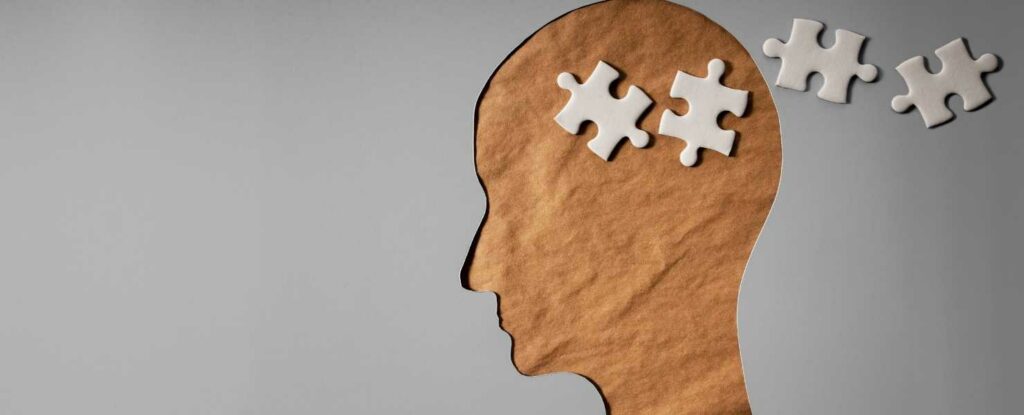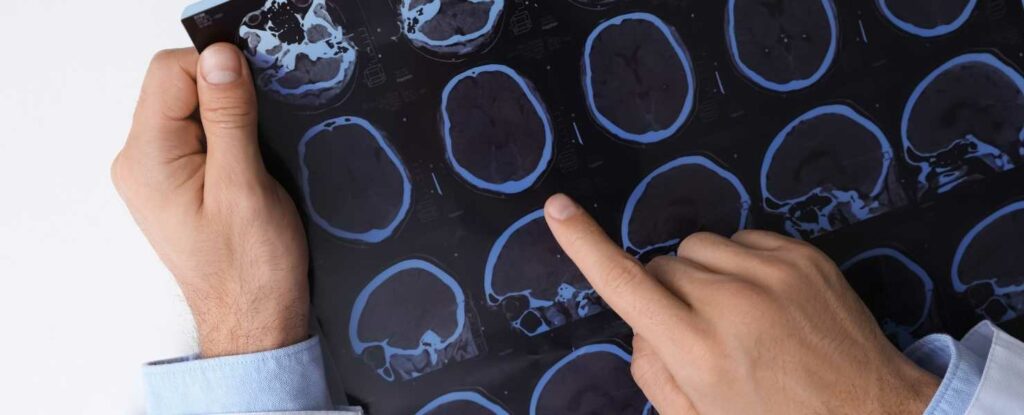Dementia is a complex condition that comes in many forms, depending on which parts of the brain are affected. Exploring dementia types can help you recognize its diverse symptoms in your aging loved one.
When someone you love develops dementia, it affects their whole interpersonal network. The ripple effect of dementia creates changes and adjustments in your life, as well as theirs.
Because dementia is such a prevalent issue, you probably already know a bit about it. But, there’s also a lot most people don’t know about dementia including the various types of dementia.
If you’re concerned your loved one may be experiencing dementia, or if your suspicions have been confirmed and you’re seeking additional info and support — this article is for you.
We’ll review the different types of dementia—to help you recognize the many ways this condition can show up in the people who have it.
For those involved with dementia study and treatment, the saying often goes: “If you’ve met one person with dementia, then you’ve met one person with dementia.”
That’s because dementia is best conceptualized as an umbrella term, under which exists a wide variety of different conditions and causations.
Dementia is actually classified as a syndrome. Characterized as a collection of common symptoms, it’s not a medical diagnosis.
That said, some specific types of dementia do carry a diagnostic label.
We’ll explore these in greater detail by reviewing the primary types of dementia.
But first, let’s take the time to clarify what dementia is, as a whole.
What is Dementia?

This holistic term encompasses a range of neurological conditions, all involving a system-wide decline in brain function.
Dementia is increasingly prevalent, particularly as modern healthcare advancements allow people to live longer than ever before. Today, the World Health Organization (WHO) estimates that approximately 55 million people are living with dementia.
More than just memory problems, dementia involves neural death in at least two portions of the brain. These neurological changes on the inside show up as behavioral and cognitive changes on the outside.
The cognitive changes seen in dementia are not part of the normal aging process.
In a recent Word to The Wise article, dementia expert, Teepa Snow, shared key facts about dementia as part of a Dementia 101 series and we highly recommend reading that article, or watching the embedded video to get a basic understanding of just what it means to have dementia.
What Are the Different Types of Dementia?

While typically conflated with memory loss, dementia shows up in many ways. In some types of dementia, memory loss is not a primary symptom. In others, memory issues don’t show up as the progressive difficulties with short term recall you may expect.
The Primary Types of Dementia are:
- Alzheimer’s disease
- Lewy Body disease
- Vascular dementia
- Frontotemporal dementia
- Dementia related to a medical diagnosis (such as Multiple Sclerosis)
- Alcohol-induced dementia
- Dementia caused by traumatic brain injury and chronic traumatic encephalopathy (CTE)
Let’s take a closer look at each of these, to understand how they show up and are distinct.
Alzheimer’s Disease

Accounting for around 70% of all cases of dementia, Alzheimer’s disease is the most common type of dementia. It’s also the type about which most people are aware. But while Alzheimer’s is the most common type of dementia — not all dementia is Alzheimer’s dementia.
Leading organizations like the National Institute on Aging and the Alzheimer’s Association estimate that more than 6 million Americans are living with Alzheimer’s disease. As our population grows and ages, so do projections for the increased prevalence of this issue.
Currently, Alzheimer’s disease is ranked the seventh leading cause of death in our country, claiming the lives of one in three adults over the age of 65.
Difficulties with recall (especially short term), communication, judgment, and behavioral changes are typical of Alzheimer’s disease. Disorientation and confusion are also commonly seen.
Dementia caused by Alzheimer’s disease can’t be confirmed with certainty until after a person has passed. But, nowadays testing advancements can predict with 80-90% accuracy whether the cognitive changes a person is experiencing are likely caused by Alzheimer’s.
Outward signs and symptoms are also used to assess if a person is likely experiencing this type of dementia.
If you’d like to learn additional facts and info about Alzheimer’s disease, this handout from the Alzheimer’s Association is a helpful resource.
Mild cognitive impairment (MCI), is the term used to describe the abnormal cognitive changes that are a precursor to Alzheimer’s disease in approximately one third of cases.
Unfortunately, many physicians report that, while they’re aware of the importance of early diagnosis of Alzheimer’s disease, they lack confidence in identifying it.
Lewy Body Disease

The second most common type of dementia is Lewy body dementia. It’s caused by an abnormal accumulation of proteins in the brain regions that are critical for memory and motor function. This protein build up impairs the ability of the brain cells it encounters to function, causing a progressive decline in cognitive and motor skills.
These abnormal structures were dubbed Lewy bodies, in honor of the doctor who first wrote about them. They are believed to be responsible for the disease. While it’s unclear what causes these structures to form, their effects are well documented.
Lewy body dementia (LBD) is typically diagnosed by doctors using a combination of brain scans and symptom assessment. They distinguish this issue from other types of dementia by looking for the three cardinal symptoms of LBD.
The three cardinal symptoms of Lewy Body Dementa are:
- Visual hallucinations
- Tremors in the extremities and muscle stiffness (also referred to as Parkinsonisms, because they’re common in people with Parkinson’s Disease).
- Mental status fluctuations
People with LBD also frequently have difficulty with attention and spatial awareness skills and may contend with mood issues, causing depression, anxiety, and impacting sleep cycles.
This type of dementia is experienced by some people with Parkinson’s disease.
Research into Lewy body disease is ongoing. Current treatment efforts are focused on the use of medications to minimize side effects, counseling, and therapy services.
Vascular Dementia

Vascular dementia is caused by issues with circulation in blood vessels in the brain and is one of the lesser known types of dementia. Our brains depend upon a steady supply of oxygen-rich blood in order to function. Deprived of this, our brain cells (known as neurons) quickly get sick and begin to die off.
In a nutshell, vascular dementia is a series of strokes. The technical name for stoke is a cerebrovascular accident, or CVA. A stroke is an accident in the blood vessels of the brain.
Because there are many blood vessels in the brain, there are different types of vascular dementia, depending on which are impacted.
Symptoms of vascular dementia vary widely, but include—
- Memory problems
- Word finding issues
- Trouble with speaking or understanding language
- Confusion and disorientation
- Issues with balance and gait
- One-sided weakness or paralysis
If you’re concerned about vascular dementia, being aware of the risk factors for stroke and working to address and manage these where possible can have a positive impact.
If you’re interested in learning more about stroke prevention, The American Stroke Association is an excellent resource. Here’s their helpful guide for managing stroke risk factors.
Frontotemporal Dementia

What if dementia doesn’t show up like you expect it to?
That’s often the case with frontotemporal dementia (FTD) as the varieties of this type don’t present as the memory issues we tend to associate with dementia, making it one of the harder types of dementia to diagnose.
In the behavioral variant type of FTD, personality changes are often the biggest symptom. The memory skills in those who experience this type of dementia can remain relatively intact in its early stages which can make it challenging to recognize and diagnose.
Named for its impact on the frontal and temporal lobes of the brain, FTD involves nerve cell damage in these crucial brain regions.
The three subtypes of frontotemporal dementia all have distinct characteristics, but FTD as a whole typically involves changes in personality, behaviors, and language skills.
Often difficult to diagnose because of its different presentation, organizations do exist to assist and support people with FTD and their families.
Dementia Due To a Medical Condition

Medical conditions, such as Multiple Sclerosis (MS), are known to cause dementia symptoms in some individuals.
Creutzfeldt-Jakob disease and Huntington’s disease are two conditions involving protein mutations in the brain, which lead to progressive dementia symptoms.
Individuals with Down syndrome have also been found to have a significantly higher risk for developing Alzheimer’s disease, due to the increased neurological impact of toxic proteins from their additional copy of chromosome 21.
People living with HIV/AIDS can also develop a type of dementia associated with this viral immune deficiency. While not every person with HIV or AIDS will develop HIV associated dementia, or AIDS Dementia Complex (ADC), they are at risk.
Alcohol-Induced Dementia

Sometimes referred to as Korsakoff syndrome or Wernicke-Korsakoff syndrome (WKS), chronic alcohol misuse can lead to cognitive decline and dementia.
This syndrome is caused by a deficiency in thiamine. This important vitamin (also known as B1) helps our bodies and brain cells convert nutrients into energy. When thiamine levels dip too low, our brains are unable to function properly.
While Korsakoff syndrome can arise from other factors, alcohol misuse is the most common cause. People with this condition tend to struggle with learning new information, and retrieving recent and long term memories.
Confabulation is another common symptom of this dementia type. This term means a person invents information that they’re unable to recall, believing it to be true. Essentially, they create stories to fill in memory gaps without realizing that they are simply fabrications.
If you have concerns about a loved one developing this type of dementia, it’s important to know the effects can be reduced or even reversed if the issue is recognized and addressed early on.
Traumatic Brain Injury and CTE-Related Dementia

While not necessarily defined as one of the several types of dementia per se, any sudden or repeated trauma to the brain can result in dementia-like symptoms. In some cases, these symptoms will improve once the brain has a chance to heal. In others, the damage and symptoms can be permanent and even progressive in nature.
Chronic Traumatic Encephalopathy (CTE) is a progressive neurological disorder that’s believed to be caused by repeated head trauma. Often associated with high-contact sports like football, this issue can lead to dementia symptom development that worsens over time.
Other Important Facts to Know About Dementia

If you’re concerned someone you love is showing symptoms of any of the above types of dementia, it can be an upsetting and confusing realization. What if your loved one is experiencing changes but their issues don’t fit neatly within the categories above?
It’s important to know that symptoms are highly variable, no matter what type of dementia we’re dealing with. If you’re noticing changes in a loved one’s behavior or cognition, it’s vital to seek out a qualified healthcare professional to help you determine next steps.
It’s also true that people can have more than one type of dementia.
Known as mixed, or mixed picture dementia, this occurs when more than one cause of dementia is present. You can learn more about this issue here.
Now that you have a bird’s eye view of the primary dementia types, you’re better equipped to recognize these signs and symptoms if they appear in someone you love.
Don’t be afraid to start a dialogue with the older adults in your life about dementia. Nowadays, there’s much research and information available about this condition, and specialists who are trained to help you approach and navigate it.
If your family has been impacted by dementia, you’re not alone. Armed with an awareness of how this condition can present itself, you’ll be better prepared to recognize its symptoms and take positive, proactive steps to cope with the changes it brings.
Speaking of support, our Word to the Wise blog regularly for helpful info and advice on a variety of important topics. We’re passionate about helping older adults, their families and caregivers—and we’re here to support you in many ways!







